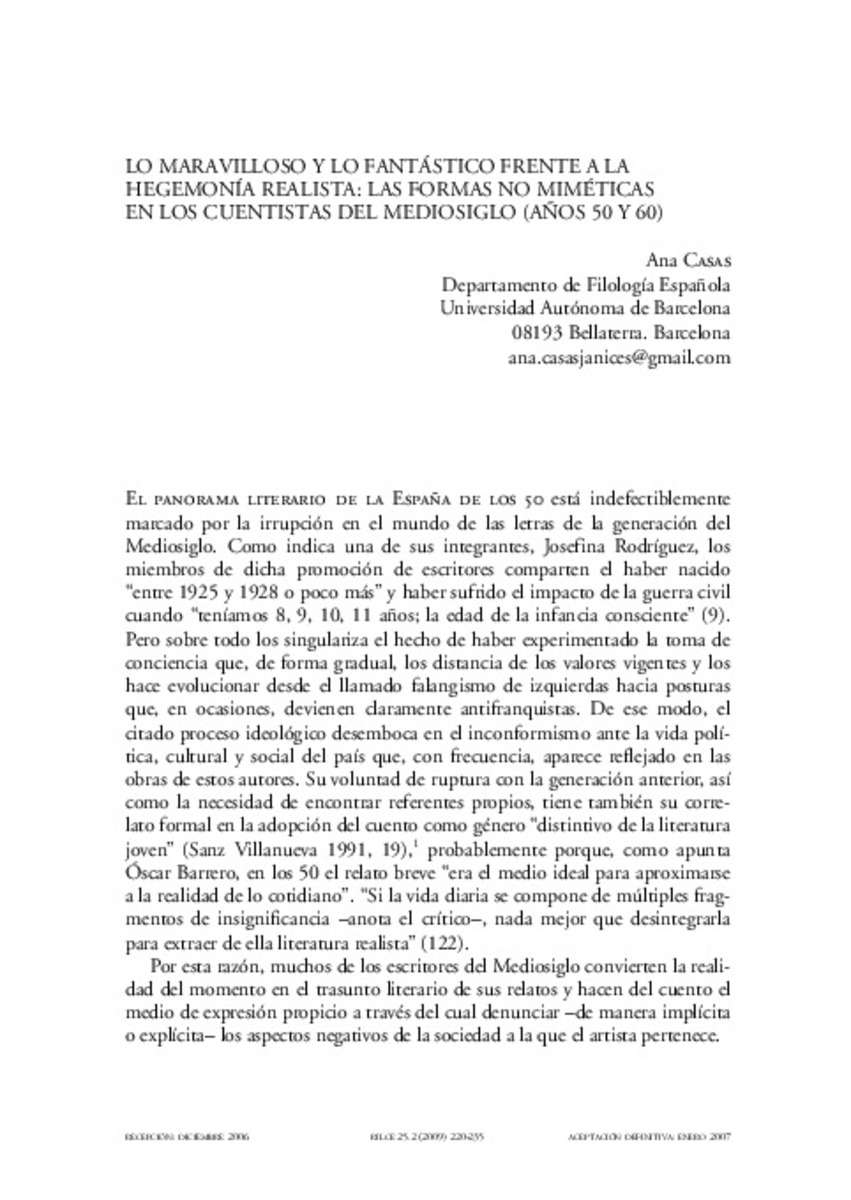Full metadata record
| DC Field | Value | Language |
|---|---|---|
| dc.creator | Casas, A. (Ana) | |
| dc.date.accessioned | 2010-06-04T11:52:42Z | - |
| dc.date.available | 2010-06-04T11:52:42Z | - |
| dc.date.issued | 2009 | - |
| dc.identifier.citation | Rilce 25.2 (2009): 220-235 | es_ES |
| dc.identifier.issn | 0213-2370 | - |
| dc.identifier.uri | https://hdl.handle.net/10171/7290 | - |
| dc.description.abstract | La crítica no ha dudado en destacar la posición preponderante del realismo en el cuento español de la segunda mitad del siglo xx, pero apenas ha calibrado la pervivencia de estéticas alejadas de dicha tendencia hegemónica a lo largo de toda la posguerra. El presente trabajo se ocupa de la producción de algunos miembros significativos de la generación del Mediosiglo, quienes, si bien optan casi siempre por un tipo de literatura comprometida y testimonial, también se interesan por el cultivo de formas no miméticas. Es el caso de Ana María Matute y Medardo Fraile, cuyos relatos ahondan en lo simbólico-existencial y en ocasiones desembocan en lo maravilloso, o de Juan Eduardo Zúñiga y Alfonso Sastre, autores que utilizan lo fantástico con el objeto de intensificar el mensaje de denuncia de la obra literaria. Criticism has no doubts when emphasizing the predominant position of realism in the second half of 20th century Spanish short stories; however, the prevalence of aesthetic streams out of this tendency all through the post-war period have been hardly pondered. This paper discuss the production of some significant members of the so-called “Mediosiglo” generation, who, although they choose a kind of compromised and testimonial literature, are also interested in the practice of non realistic forms. This is the case for Ana María Matute and Medardo Fraile, whose stories go into the symbolic existentialism in depth and, sometimes, culminate inthe marvellous genre, or for Juan Eduardo Zúñiga and Alfonso Sastre, who use the fantastic genre with the purpose of stepping up the message of denounce of the literary work. | es_ES |
| dc.language.iso | spa | es_ES |
| dc.publisher | Servicio de Publicaciones de la Universidad de Navarra | es_ES |
| dc.rights | info:eu-repo/semantics/openAccess | es_ES |
| dc.subject | Lo fantástico | es_ES |
| dc.subject | Cuento | es_ES |
| dc.subject | Narrativa española de posguerra | es_ES |
| dc.subject | The fantastic literature | es_ES |
| dc.subject | Short story | es_ES |
| dc.subject | Spanish post-war fiction | es_ES |
| dc.title | Lo maravilloso y lo fantástico frente a la hegemonía realista: las formas no miméticas en los cuentistas del Mediosiglo (años 50 y 60) | es_ES |
| dc.type | info:eu-repo/semantics/article | es_ES |
| dc.identifier.doi | 10.15581/008.25.26299 | es_ES |
Files in This Item:
Statistics and impact
Items in Dadun are protected by copyright, with all rights reserved, unless otherwise indicated.






